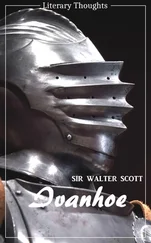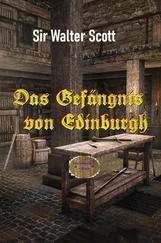Walter Scott - Ivanhoe
Здесь есть возможность читать онлайн «Walter Scott - Ivanhoe» — ознакомительный отрывок электронной книги совершенно бесплатно, а после прочтения отрывка купить полную версию. В некоторых случаях можно слушать аудио, скачать через торрент в формате fb2 и присутствует краткое содержание. Жанр: Исторические приключения, на английском языке. Описание произведения, (предисловие) а так же отзывы посетителей доступны на портале библиотеки ЛибКат.
- Название:Ivanhoe
- Автор:
- Жанр:
- Год:неизвестен
- ISBN:нет данных
- Рейтинг книги:4 / 5. Голосов: 1
-
Избранное:Добавить в избранное
- Отзывы:
-
Ваша оценка:
- 80
- 1
- 2
- 3
- 4
- 5
Ivanhoe: краткое содержание, описание и аннотация
Предлагаем к чтению аннотацию, описание, краткое содержание или предисловие (зависит от того, что написал сам автор книги «Ivanhoe»). Если вы не нашли необходимую информацию о книге — напишите в комментариях, мы постараемся отыскать её.
Ivanhoe — читать онлайн ознакомительный отрывок
Ниже представлен текст книги, разбитый по страницам. Система сохранения места последней прочитанной страницы, позволяет с удобством читать онлайн бесплатно книгу «Ivanhoe», без необходимости каждый раз заново искать на чём Вы остановились. Поставьте закладку, и сможете в любой момент перейти на страницу, на которой закончили чтение.
Интервал:
Закладка:
CHAPTER XXXVIII
1 (p. 383) epigraph: The lines, slightly altered, are from Shakespeare’s Richard II (act 4, scene 1).
2 (p. 388) “even as the signet of the mighty Solomon was said to command the evil genii: The Koran records that God gave Solomon power over the genii. It is only tradition, however, possibly derived from its mention in The Arabian Nights, which locates the power in his signet ring.
3 (p. 389) Benoni: The name, which means ”son of my sorrow” in Hebrew, was given by the dying Rachel to her son in the Bible, Genesis 35:18. Jacob would rename him Benjamin, and the boy became his ill-fated favorite.
4 (p. 389) gourd of Jonah: Isaac is referring not to a cup, but rather to the fruit tree God provided for Jonah, which became infested with worms overnight and died. See the Bible, Jonah 4:7.
5 (p. 390) Boabdil the Saracen: This is a glaring anachronism. Boabdil was the last Moorish king of Grenada (1482-1492), under whose reign Jews enjoyed equal rights and freedoms with other citizens. When a Christian army reconquered Spain in 1492, the Jews were expelled and sought sanctuary in the Islamic east and the Ottoman Empire.
CHAPTER XXXIX
1 (p. 392) epigraph: The lines, slightly altered, are from Anna Seward’s ”From Thy Waves, Stormy Lannow, I Fly” (1799; lines 6-7) . Scott edited a three-volume edition of Seward’s poetry, published in 1810.
2 (p. 397) heaven … nearly scaled: In the first book of Ovid’s Metamorphoses, the Titans pile up rocks toward the heavens in an effort to overthrow the Olympian gods. Poet John Keats inverted the myth by having the Olympian gods overthrow the Titans in his Miltonic epic fragment ”Hyperion,” written in the same year as Ivanhoe.
CHAPTER XL
1 (p. 404) epigraph: The line is not from Shakespeare, but from Colley Cibber’s subliterary revision The Tragicall History of King Richard III (1700), which was the version of the play known to British theatergoers for more than a hundred years.
2 (p. 418) ”I am Robin Hood of Sherwood Forest”: [Author’s note] Locksley. From the ballads of Robin Hood, we learn that this celebrated outlaw, when in disguise, sometimes assumed the name of Locksley, from a village where he was born, but where situated we are not distinctly told.—
According to tradition, a village of this name was the birth-place of Robin Hood, while the county in which it was situated remains undetermined. There is a broadside printed about the middle of the 17th century with the title of A New Ballad of Bold Robin Hood, showing his birth, etc., calculated for the meridian of Staffordshire. But in the ballad itself, it says—
In Locksley town, in merry Nottinghamshire,
In merry sweet Locksley town,
There bold Robin Hood, he was born and was bred,
Bold Robin of famous renown.
Ritson says, it may serve quite as well for Derbyshire or Kent as for Nottingham (Laing).
CHAPTER XLI
1 (p. 421) epigraph: These lines, slightly altered, are from an opera by Andrew Macdonald called Love and Loyalty (1788). Many of Scott’s novels were adapted for the operatic stage, most famously Lucia di Lammermoor (1835), by Donizetti.
2 (p. 423) “The Chancellor must make sure of London”: William de Longchamp was Richard I’s chancellor and longtime ally; he was left in charge of much of the kingdom’s affairs on Richard’s leaving for the Third Crusade in 1789. On finding that authority usurped by the scheming John, William left for Germany. He was principally responsible for the raising of Richard’s ransom money; on the King’s return, he resumed the office of chancellor.
3 (p. 427) the Charter of the Forest was extorted from the unwilling hands of King John when he succeeded to his heroic brother: This is a specific instance of Scott’s altering the historical record to Richard’s advantage. The Lion-Heart was in fact a champion of the Norman forest laws, and the liberalizing Charter of the Forest was not signed until after John’s death.
4 (p. 427) treacherous death… weight in gold: According to legend, as recorded in the broadsheet ballads of the Middle Ages (that is, the “black-letter garlands”), Robin Hood was poisoned by his cousin, the Prioress of Kirlees. The quotation is from John Ferriar’s “The Bibliomania” (1809).
5 (p. 428) various monuments … are shown in the neighboring churchyard: [Author’s note] Castle of Coningsburgh. When I last saw this interesting ruin of ancient days, one of the very few remaining examples of Saxon fortification, I was strongly impressed with the desire of tracing out a sort of theory on the subject, which, from some recent acquaintance with the architecture of the ancient Scandinavians, seemed to me peculiarly interesting. I was, however, obliged by circumstances to proceed on my journey, without leisure to take more than a transient view of Coningsburgh. Yet the idea dwells so strongly in my mind, that I feel considerably tempted to write a page or two in detailing at least the outline of my hypothesis, leaving better antiquaries to correct or refute conclusions which are perhaps too hastily drawn.
Those who have visited the Zetland Islands are familiar with the description of castles called by the inhabitants burghs, and by the Highlanders—for they are also to be found both in the Western Isles and on the mainland—duns. Pennant has engraved a view of the famous Dun Dornadilla in Glenelg; and there are many others, all of them built after a peculiar mode of architecture, which argues a people in the most primitive state of society. The most perfect specimen is that upon the island of Mousa, near to the Mainland of Zetland, which is probably in the same state as when inhabited.
It is a single round tower, the wall curving in slightly, and then turning outward again in the form of a dice-box, so that the defenders on the top might the better protect the base. It is formed of rough stones, selected with care, and laid in courses or circles, with much compactness, but without cement of any kind. The tower has never, to appearance, had roofing of any sort; a fire was made in the centre of the space which it incloses, and originally the building was probably little more than a wall drawn as a sort of screen around the great council fire of the tribe. But, although the means or ingenuity of the builders did not extend so far as to provide a roof, they supplied the want by constructing apartments in the interior of the walls of the tower itself. The circumvallation formed a double inclosure, the inner side of which was, in fact, two feet or three feet distant from the other, and connected by a concentric range of long flat stones, thus forming a series of concentric rings or stories of various heights, rising to the top of the tower. Each of these stories or galleries has four windows, facing directly to the points of the compass, and rising, of course, regularly above each other. These four perpendicular ranges of windows admitted air, and, the fire being kindled, heat, or smoke at least, to each of the galleries. The access from gallery to gallery is equally primitive. A path, on the principle of an inclined plane, turns round and round the building like a screw, and gives access to the different stories, intersecting each of them in its turn, and thus gradually rising to the top of the wall of the tower. On the outside there are no windows; and I may add that an inclosure of a square, or sometimes a round, form gave the inhabitants of the burgh an opportunity to secure any sheep or cattle which they might possess.
Читать дальшеИнтервал:
Закладка:
Похожие книги на «Ivanhoe»
Представляем Вашему вниманию похожие книги на «Ivanhoe» списком для выбора. Мы отобрали схожую по названию и смыслу литературу в надежде предоставить читателям больше вариантов отыскать новые, интересные, ещё непрочитанные произведения.
Обсуждение, отзывы о книге «Ivanhoe» и просто собственные мнения читателей. Оставьте ваши комментарии, напишите, что Вы думаете о произведении, его смысле или главных героях. Укажите что конкретно понравилось, а что нет, и почему Вы так считаете.








